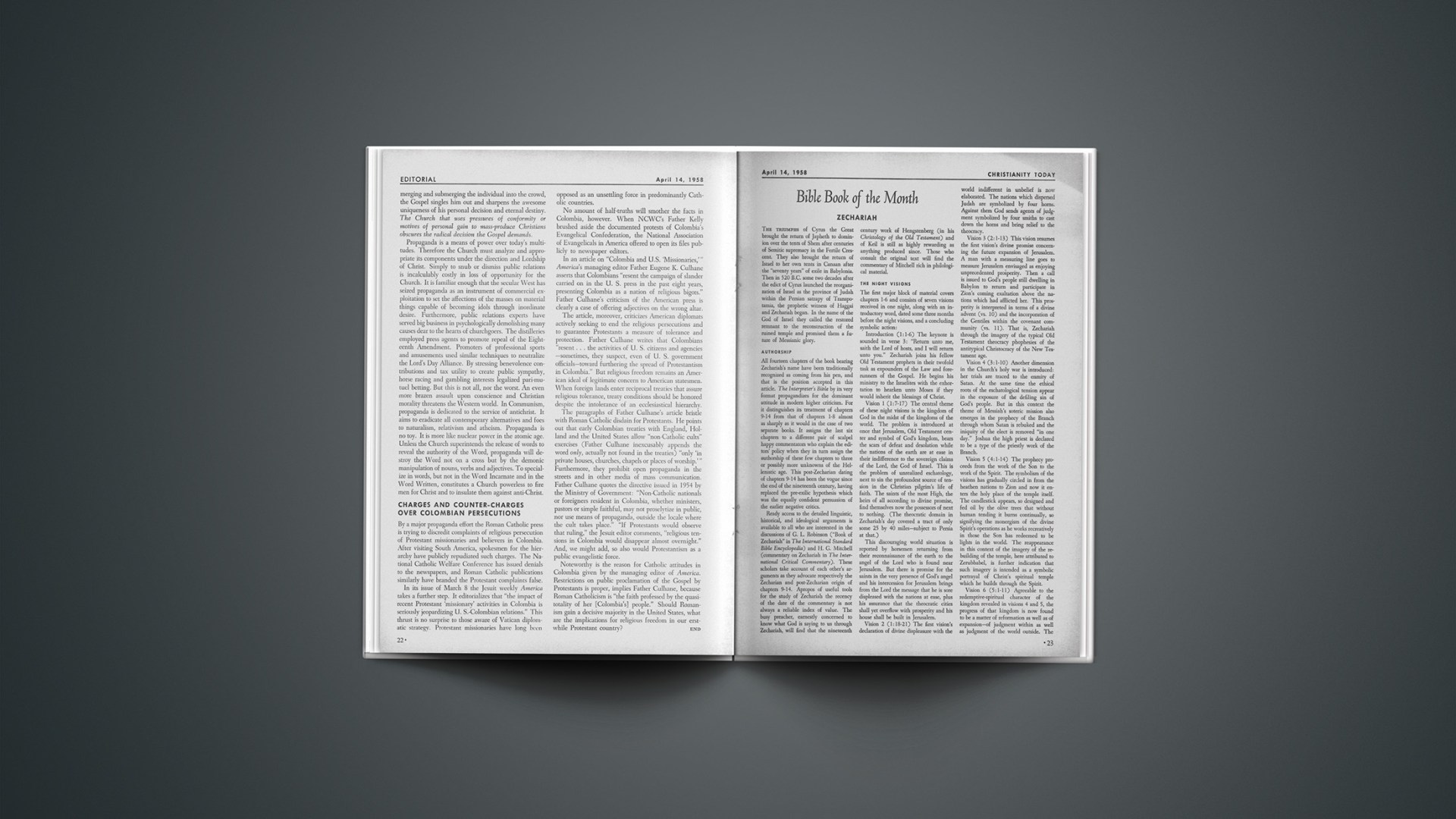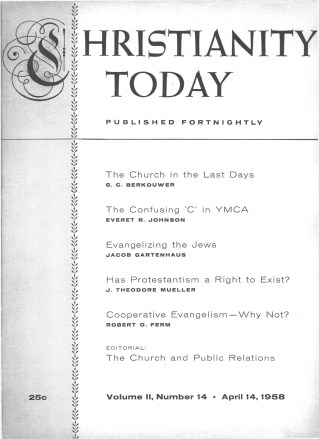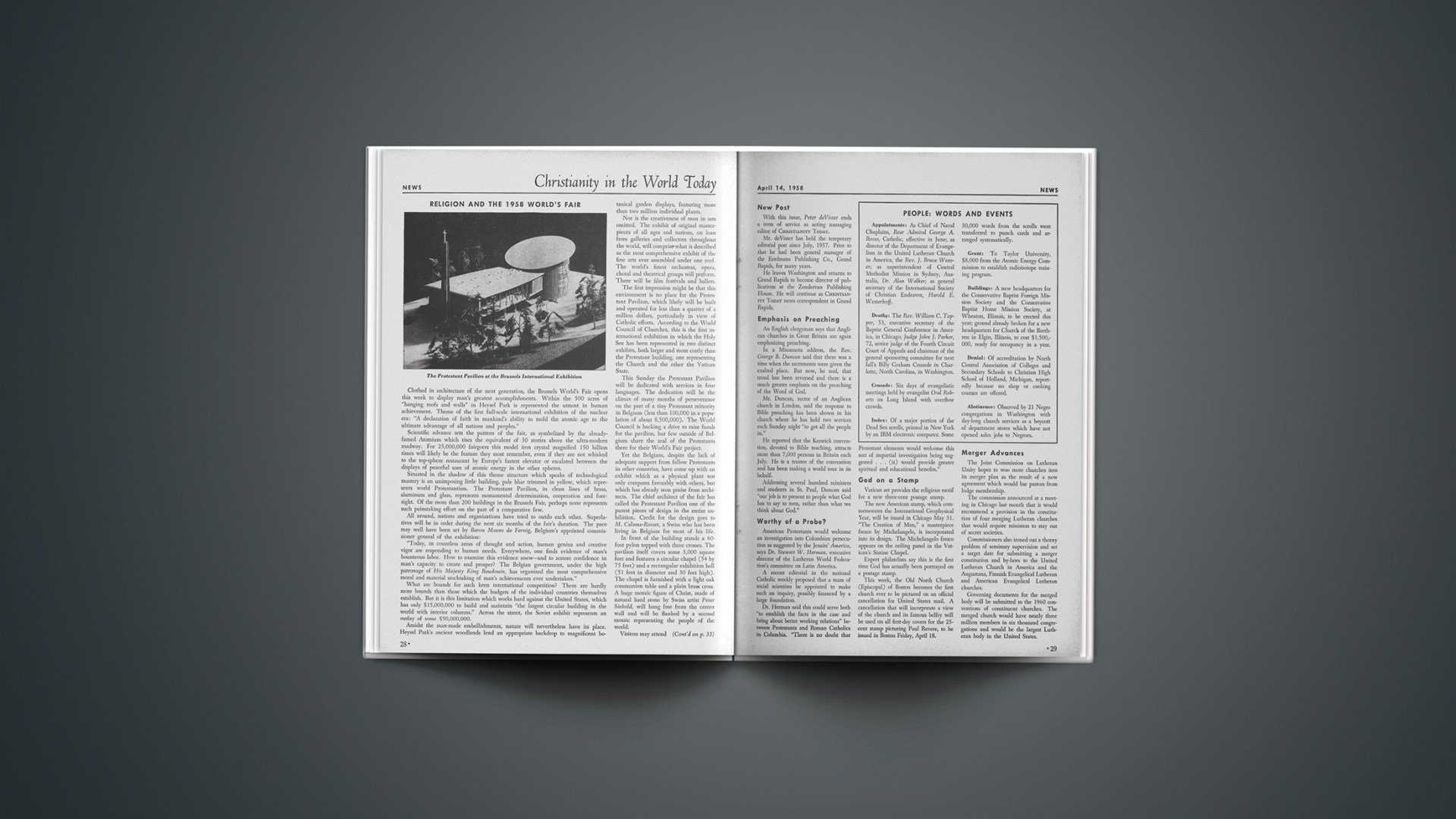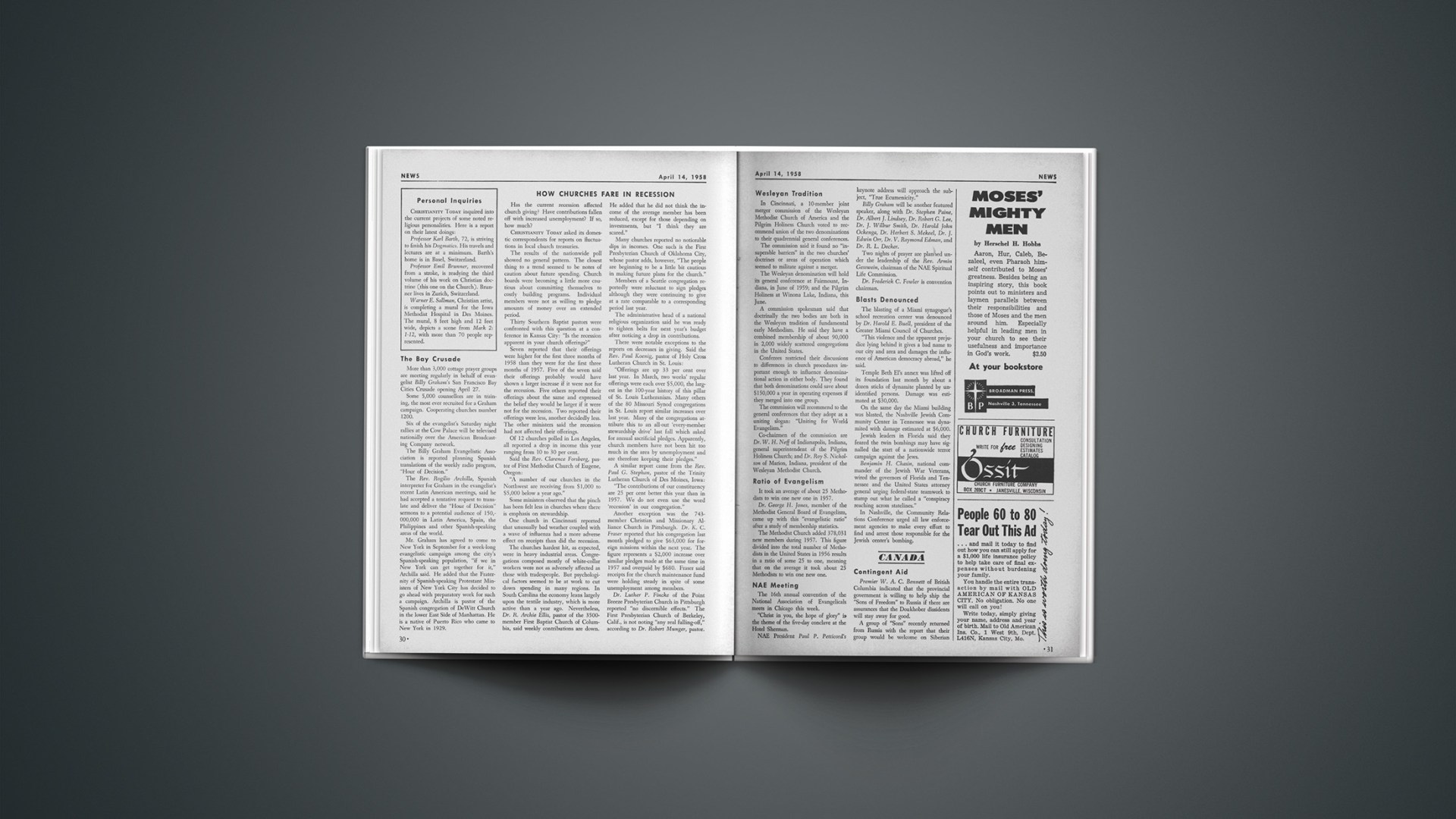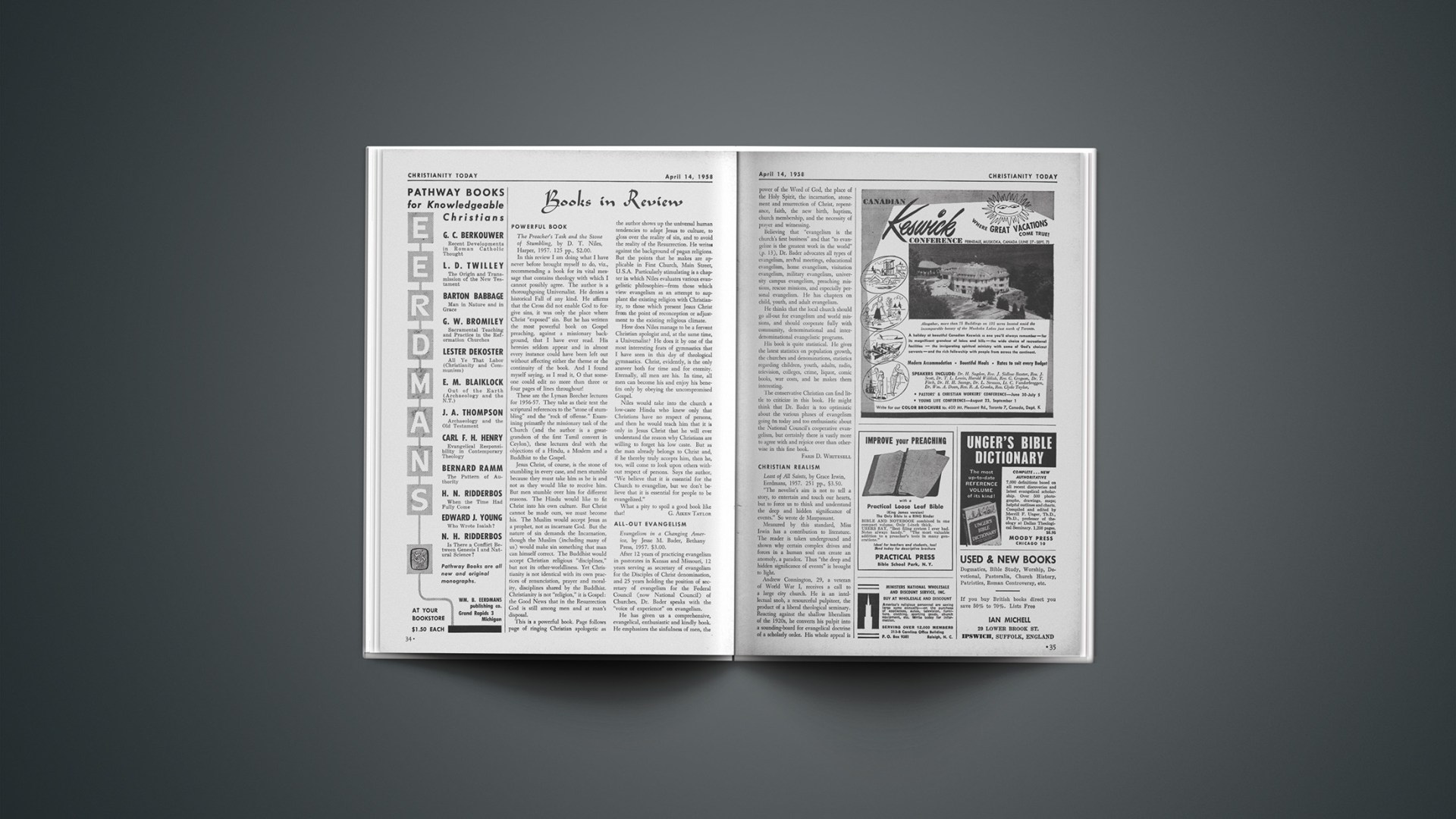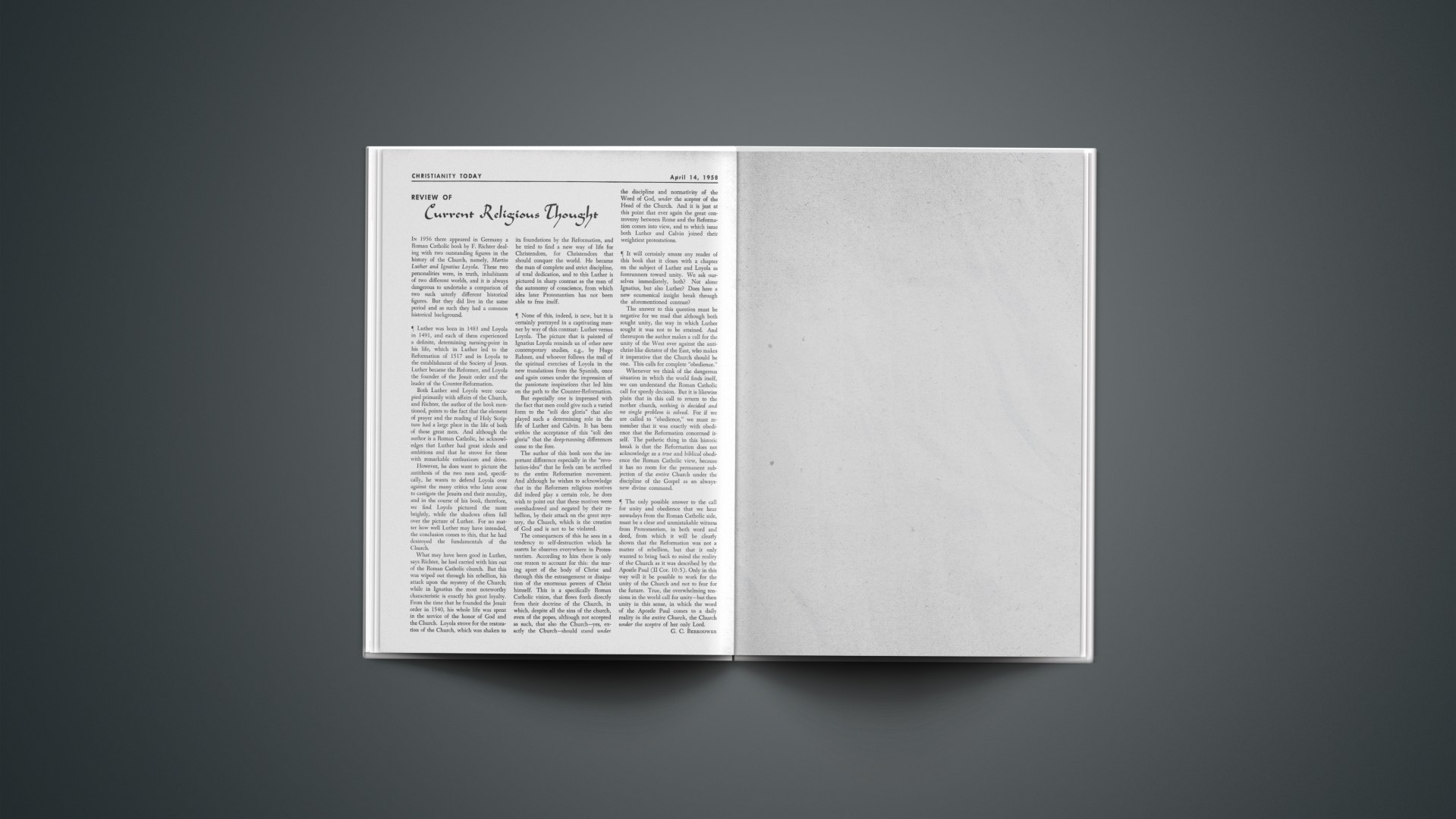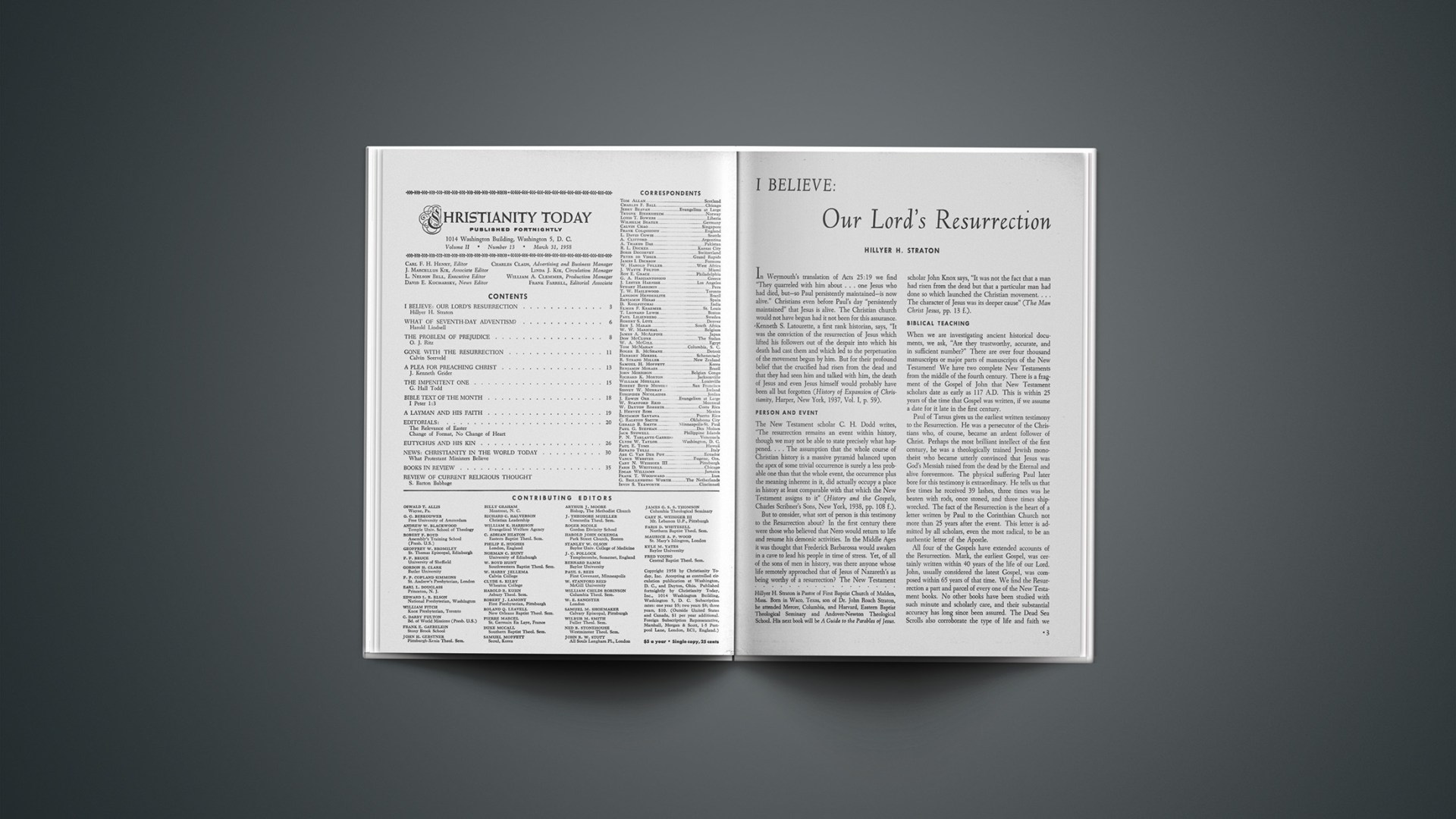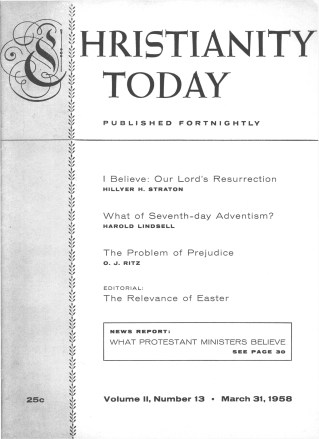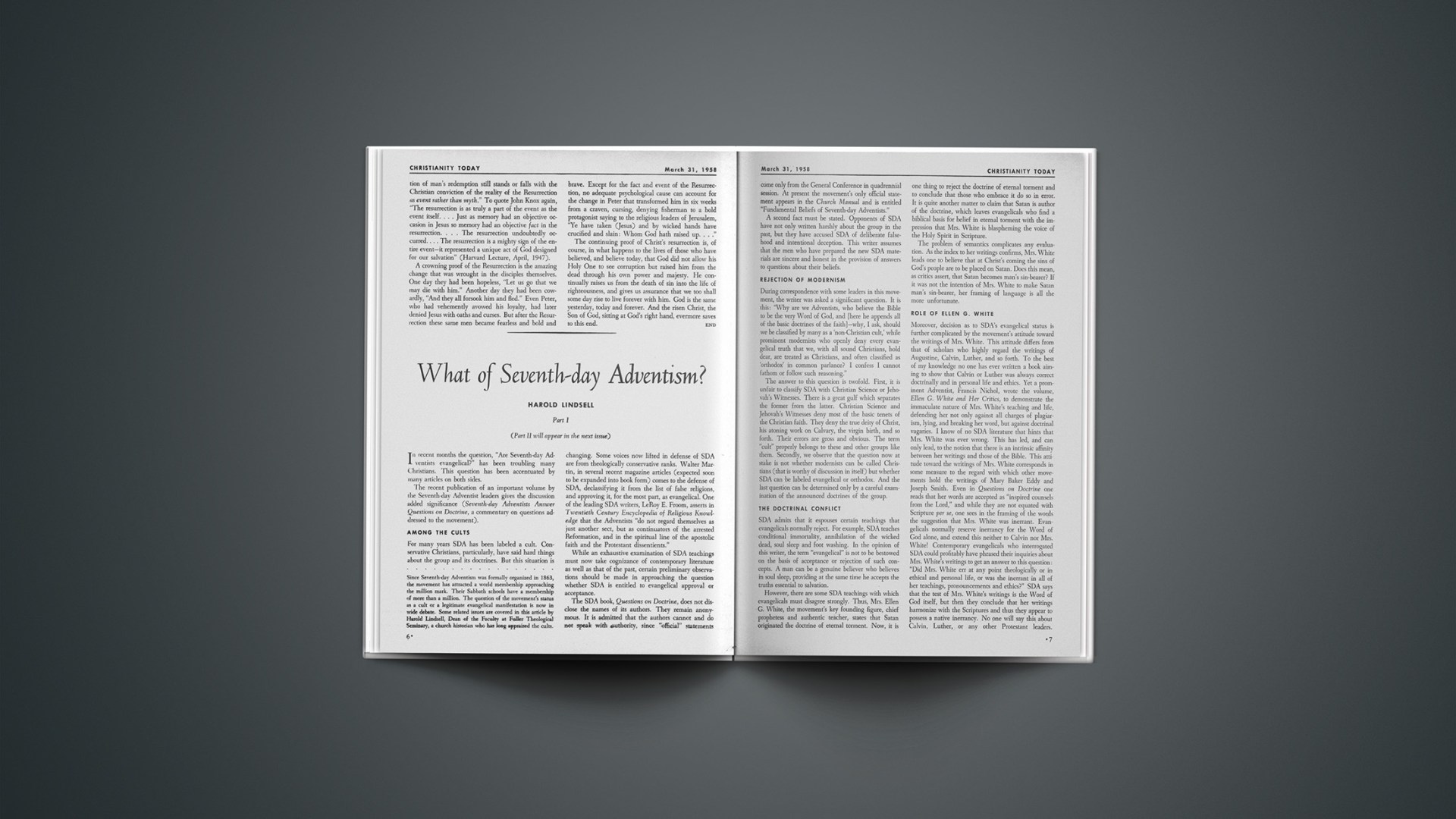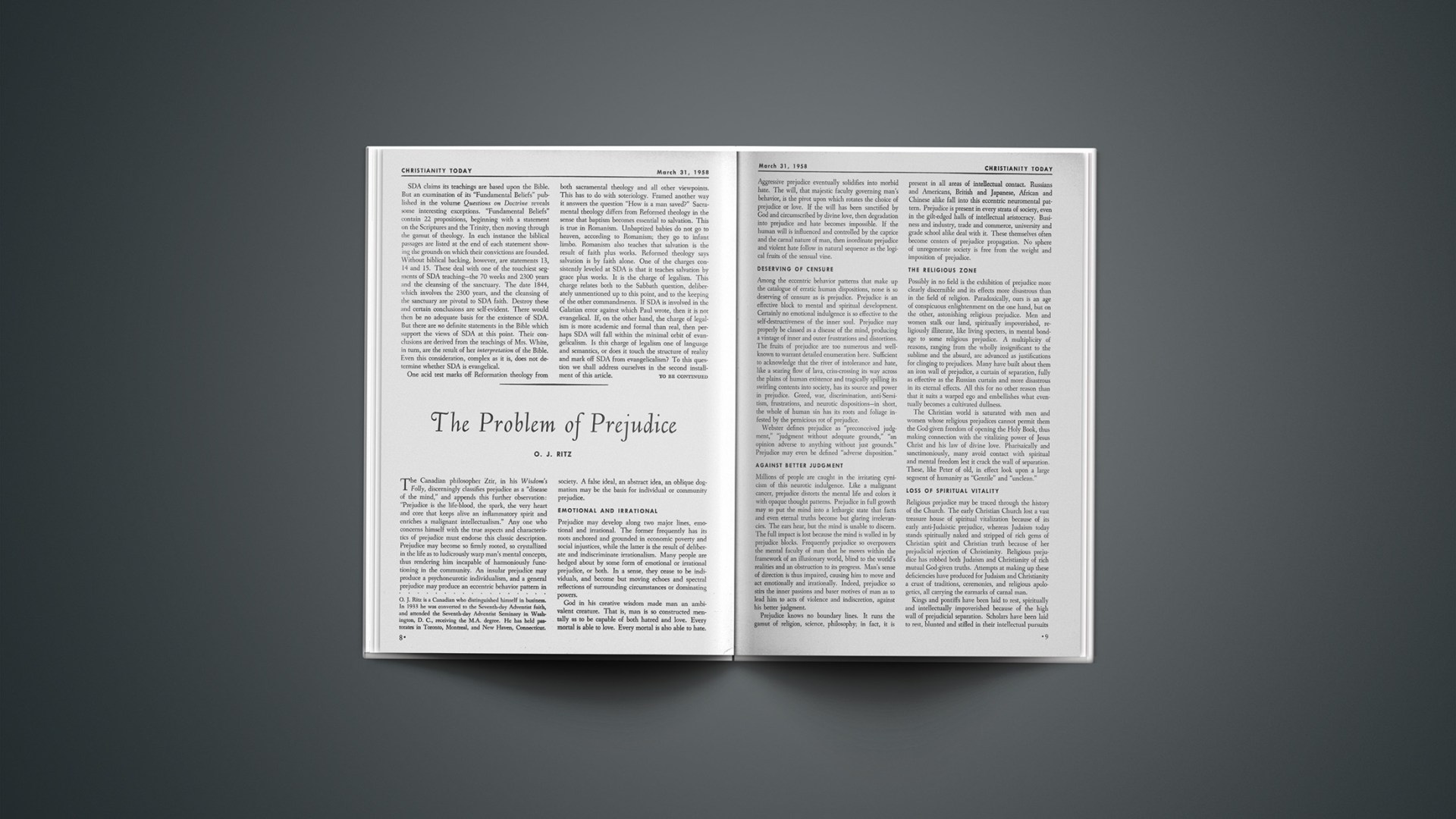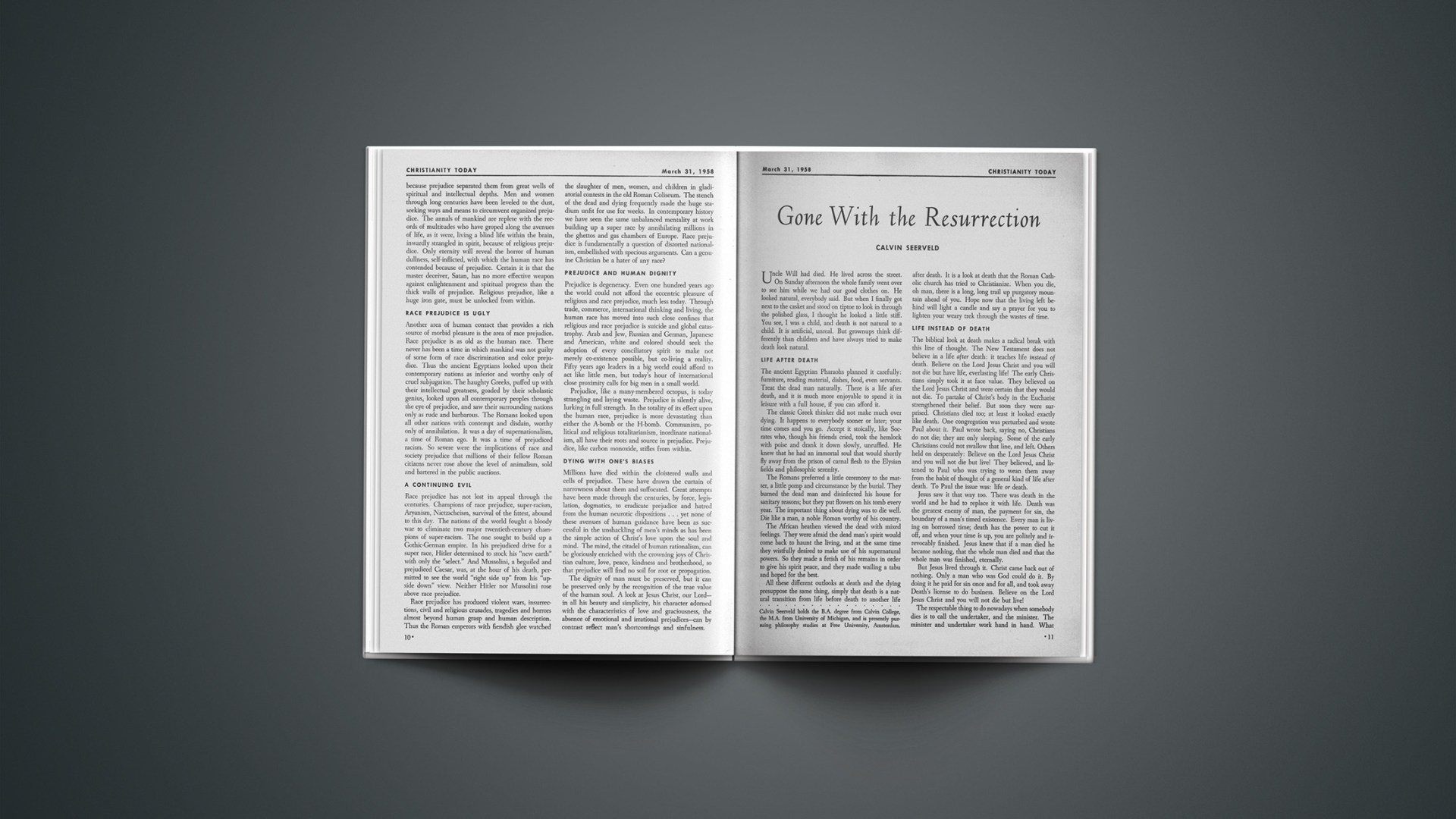Zechariah
The triumphs of Cyrus the Great brought the return of Japheth to dominion over the tents of Shem after centuries of Semitic supremacy in the Fertile Crescent. They also brought the return of Israel to her own tents in Canaan after the “seventy years” of exile in Babylonia. Then in 520 B.C. some two decades after the edict of Cyrus launched the reorganization of Israel as the province of Judah within the Persian satrapy of Transpotamia, the prophetic witness of Haggai and Zechariah began. In the name of the God of Israel they called the restored remnant to the reconstruction of the ruined temple and promised them a future of Messianic glory.
Authorship
All fourteen chapters of the book bearing Zechariah’s name have been traditionally recognized as coming from his pen, and that is the position accepted in this article. The Interpreter’s Bible by its very format propagandizes for the dominant attitude in modern higher criticism. For it distinguishes its treatment of chapters 9–14 from that of chapters 1–8 almost as sharply as it would in the case of two separate books. It assigns the last six chapters to a different pair of scalpel happy commentators who explain the editors’ policy when they in turn assign the authorship of these few chapters to three or possibly more unknowns of the Hellenistic age. This post-Zecharian dating of chapters 9–14 has been the vogue since the end of the nineteenth century, having replaced the pre-exilic hypothesis which was the equally confident persuasion of the earlier negative critics.
Ready access to the detailed linguistic, historical, and ideological arguments is available to all who are interested in the discussions of G. L. Robinson (“Book of Zechariah” in The International Standard Bible Encyclopedia) and H. G. Mitchell (commentary on Zechariah in The International Critical Commentary). These scholars take account of each other’s arguments as they advocate respectively the Zecharian and post-Zecharian origin of chapters 9–14. Apropos of useful tools for the study of Zechariah the recency of the date of the commentary is not always a reliable index of value. The busy preacher, earnestly concerned to know what God is saying to us through Zechariah, will find that the nineteenth century work of Hengstenberg (in his Christology of the Old Testament) and of Keil is still as highly rewarding as anything produced since. Those who consult the original text will find the commentary of Mitchell rich in philological material.
The Night Visions
The first major block of material covers chapters 1–6 and consists of seven visions received in one night, along with an introductory word, dated some three months before the night visions, and a concluding symbolic action:
Introduction (1:1–6) The keynote is sounded in verse 3: “Return unto me, saith the Lord of hosts, and I will return unto you.” Zechariah joins his fellow Old Testament prophets in their twofold task as expounders of the Law and forerunners of the Gospel. He begins his ministry to the Israelites with the exhortation to hearken unto Moses if they would inherit the blessings of Christ.
Vision 1 (1:7–17) The central theme of these night visions is the kingdom of God in the midst of the kingdoms of the world. The problem is introduced at once that Jerusalem, Old Testament center and symbol of God’s kingdom, bears the scars of defeat and desolation while the nations of the earth are at ease in their indifference to the sovereign claims of the Lord, the God of Israel. This is the problem of unrealized eschatology, next to sin the profoundest source of tension in the Christian pilgrim’s life of faith. The saints of the most High, the heirs of all according to divine promise, find themselves now the possessors of next to nothing. (The theocratic domain in Zechariah’s day covered a tract of only some 25 by 40 miles—subject to Persia at that.)
This discouraging world situation is reported by horsemen returning from their reconnaissance of the earth to the angel of the Lord who is found near Jerusalem. But there is promise for the saints in the very presence of God’s angel and his intercession for Jerusalem brings from the Lord the message that he is sore displeased with the nations at ease, plus his assurance that the theocratic cities shall yet overflow with prosperity and his house shall be built in Jerusalem.
Vision 2 (1:18–21) The first vision’s declaration of divine displeasure with the world indifferent in unbelief is now elaborated. The nations which dispersed Judah are symbolized by four horns. Against them God sends agents of judgment symbolized by four smiths to cast down the horns and bring relief to the theocracy.
Vision 3 (2:1–13) This vision resumes the first vision’s divine promise concerning the future expansion of Jerusalem. A man with a measuring line goes to measure Jerusalem envisaged as enjoying unprecedented prosperity. Then a call is issued to God’s people still dwelling in Babylon to return and participate in Zion’s coming exaltation above the nations which had afflicted her. This prosperity is interpreted in terms of a divine advent (vs. 10) and the incorporation of the Gentiles within the covenant community (vs. 11). That is, Zechariah through the imagery of the typical Old Testament theocracy phophesies of the antitypical Christocracy of the New Testament age.
Vision 4 (3:1–10) Another dimension in the Church’s holy war is introduced: her trials are traced to the enmity of Satan. At the same time the ethical roots of the eschatological tension appear in the exposure of the defiling sin of God’s people. But in this context the theme of Messiah’s soteric mission also emerges in the prophecy of the Branch through whom Satan is rebuked and the iniquity of the elect is removed “in one day.” Joshua the high priest is declared to be a type of the priestly work of the Branch.
Vision 5 (4:1–14) The prophecy proceeds from the work of the Son to the work of the Spirit. The symbolism of the visions has gradually circled in from the heathen nations to Zion and now it enters the holy place of the temple itself. The candlestick appears, so designed and fed oil by the olive trees that without human tending it burns continually, so signifying the monergism of the divine Spirit’s operations as he works recreatively in those the Son has redeemed to be lights in the world. The reappearance in this context of the imagery of the rebuilding of the temple, here attributed to Zerubbabel, is further indication that such imagery is intended as a symbolic portrayal of Christ’s spiritual temple which he builds through the Spirit.
Vision 6 (5:1–11) Agreeable to the redemptive-spiritual character of the kingdom revealed in visions 4 and 5, the progress of that kingdom is now found to be a matter of reformation as well as of expansion—of judgment within as well as judgment of the world outside. The removal of covenant-breakers is symbolized by the destruction of their houses in the holy land and the construction of a new dwelling to which they are transported in the world-sphere of Shinar. This complements the call to believers lingering in Babylon to come home to Zion and the flocking to Zion of the converted Gentiles (vision 3), the net effect being the sharp separation of the Church from the world which prepares for the final scene of eschatological triumph.
Vision 7 (6:1–8) Under the symbolism of four chariots of judgment which go to the several points of the compass and appease the wrath of God there is depicted the final judgment of the Serpent’s seed. The earth is thus cleared of foes to become from sea to sea the inheritance of all who are Christ’s, and therefore are Abraham’s seed, heirs according to the promise.
Concluding Symbolic Transaction (6:9–15). The Lord requires Zechariah to make a crown of silver and gold offered by returned exiles and with it to crown the high priest Joshua king. Thus in striking symbolism the Messianic figure of the Branch, singled out of the preceding visions for closing attention, is shown to combine in one person the offices of both Joshua and Zerubbabel. Christ is revealed as a priest who builds his own temple, unto which men come from afar to take their place—as a priest who reigns as king from the glory of his throne.
A Rebuff To Formalists
The occasion of the prophesying of chapters 7 and 8 was the arrival, almost two years after the night visions, of a delegation from Bethel, posing to the priests and prophets at Jerusalem a theological problem. Was it necessary in their days of restoration to continue the observance of fasts instituted in remembrance of the destruction of Jerusalem? (7:1–3).
In reply Zechariah first confronts the delegation with the teaching of the past (7:4–14). The loss of God’s favor manifested in the fall of Jerusalem had been due to no want of formal ritual on Israel’s part but to their failure to bring forth the righteous fruits of their covenant privileges. This reply cuts through the delegation’s superficial formulation of the question and convicts of the basic realities of sin, righteousness, and judgment. Zechariah points to obedience to the covenant ethic (not to a concern about self-righteous ceremonialism) as the way to continued covenant favor.
He next enforces this lesson of Israel’s past by coupling with promises of the future transformation of all Jerusalem’s fasts into feasts and the conversion of the nations to Israel’s God the demand for a response of love and truth to the covenant grace of God (ch. 8).
Chapters 7 and 8 are transitional in the structure of the book. They provide a hortatory introduction to the “burdens” of chapters 9–14 while they bring the night visions full circle with a clear echo of the keynote theme sounded in the opening verses. Their non-visionary form also prepares stylistically for the following oracles at the same time that they share with the preceding chapters an orientation to the concrete situation of the returned exiles. A further element of continuity found in this section is its utilization, in common with all the rest of the book, of the symbol of a flourishing Jerusalem as the sanctuary of the converted nations in its preview of the Kingdom of God during the Messianic age.
Hadrach And Israel
Chapters 9–14 consist of a “burden” on Hadrach (9–11) and a “burden” on Israel (12–14). These are not dated but presumably come from a later period in Zechariah’s ministry. A few major strands in the eschatology of these chapters are selected for brief comment here. With an eye to the Zecharian authorship of the whole book note will be taken of the continuity in eschatological perspective between chapters 1–8 and 9–14.
The Casting Away of Israel: Chapter 5 had expounded the keynote principle that one’s continuance in the privileges of God’s kingdom depended on his manifestation of the righteousness of that kingdom. It pictured the covenant-breakers being cut off and driven into permanent exile. That theme is continued in chapters 9–14.
According to 13:7, 8a, as an immediate sequel to the suffering of the Messianic shepherd, a judgment falls upon the covenant flock which results in the cutting off of the majority. A more extended treatment of this dark prospect is found in chapter 11. Here the judgment is traced to the general apostasy of Israel, expressed climactically in her failure to recognize the hour of Messianic visitation. Israel and most of all Israel’s leaders despise the Good Shepherd. The consequent judgment involves not only the abandonment of the majority of the flock to destruction but the termination in wrath of the Old Testament theocratic order. The religious hierarchy is cut off; the promised land is made desolate.
In short, Zechariah expected that the consummation of the kingdom’s blessings which he foretells in other passages must be realized in spite of a divine judgment against Israel of such proportions as to be called the fall or casting away of Israel. This is ignored by the commentators who make facile charges of chauvinism against the author.
The Double Remnant: The casting away of Israel is not fatal to the continuity of the covenant program because the Lord saves out of Israel a remnant according to the election of grace. The Old Testament, however, anticipated more than mere continuity. There was to be glorious fullness and Zechariah provides the explanation of that fullness when he prophesies of the salvation of a remnant of the Gentiles. He is not, therefore, narrowly nationalistic but cherishes the hope of universalism.
The motif of the remnant of Israel informs the whole historic situation to which Zechariah immediately addressed himself in the days of partial restoration after the Exile (cf. especially chapters 1, 7 and 8). The idea of the remnant is, moreover, the necessary corollary to the excision of the covenant-breakers in chapter 5. The prophet repeats this theme in the later chapters 11:7, 11; 13:8b, 9; cf. 10:6–12; 14:2.
The conversion of the nations is predicted in the earlier chapters in the third vision (2:11; cf. 6:15) and in the reply to the Bethel delegation (8:22, 23); it is found in chapters 9–14 in 9:7, 10; 14:16. The participation of the remnant of the Gentiles in the blessings of the Abrahamic covenant is also repeatedly symbolized by the unprecedented expansion of “Jerusalem.” Thus throughout all 14 chapters is taught the doctrine of the double remnant.
The Final Judgment
The Judgment of the Hostile Nations: The universalism of salvation is not distributive. It is only a remnant of the heathen who are saved. The world looming large in its hostility to the covenant community forms part of Zechariah’s outlook throughout his book. The world-power is depicted in various ungodly attitudes. Now they are at ease and indifferent (1:7, 15). Now they attack God’s kingdom (1:18 ff.; 12:1 ff.; 14:1 ff.). Again, they are found occupying the promised inheritance of the saints (ch. 9).
Corresponding to this rebelliousness of the world is the recurring theme of the final judgment of the nations. They are to be cast down and dispossessed. They are to become a spoil to God’s people. The arrow of God will go forth against them and he will “destroy all the nations that come against Jerusalem.” The last glimpse the Seer catches of that world finds it reeling under the wrath of the Almighty gone forth in deference of the remnant of his people. In the visions see 1:15, 21; 2:9; 6:1–8. In the final “burdens” see chapter 9; 12:1–9 and 14:3,12–15.
Messiah, Divine Priest-King: As a final strand in Zechariah’s eschatology the Messianic must be mentioned because of its inherent importance and because Zechariah’s treatment of it is especially rich. Repeatedly Messiah appears as the agent of the divine salvation of the double remnant or the divine judgment on apostate Israel and the hostile world.
In the night visions the Messiah is represented by Old Testament figures who typified him and his work—Joshua the high priest and the governor Zurub-babel, heir to David’s throne. There also appears the angel of the Lord, pre-Incarnate theophany form of Messiah, and there is the direct in-breaking of the voice of Messiah speaking in the first person. In chapters 9–14 the figure of the Messiah himself appears although in chapter 11 he stands behind the transparent form of the prophet Zechariah who enacts the role of the Messianic shepherd. These differences in revelational form are due to the differing literary forms in various parts of the book. What is more significant is the harmony of all the chapters in their concept of Messiah’s person and work.
The deity of the Christ is revealed in 2:8; 12:10; 13:7.
Very prominent is the union in Christ of priestly and kingly office and function. It is most strikingly portrayed in the scene of the high priest Joshua’s coronation (6:11, 12; cf. 4:11–14). That scene gathers together the teaching of the preceding visions which had already presented Messiah as priestly intercessor (1:12) and iniquity remover (3:9), and as royal governor and temple builder (4:6–10).
The same two strands intertwine in chapters 9–12. These make mention of his sorrow and sufferings as one despised and betrayed (11:8b, 12, 13), pierced and smitten of the sword (12:10; 13:7) as he came lowly and having salvation (9:9). But they also call him Zion’s king (9:9) who as shepherd-king governs the flock of his people and executes judgment against their oppressors (11:7, 8).
MEREDITH G. KLINE

